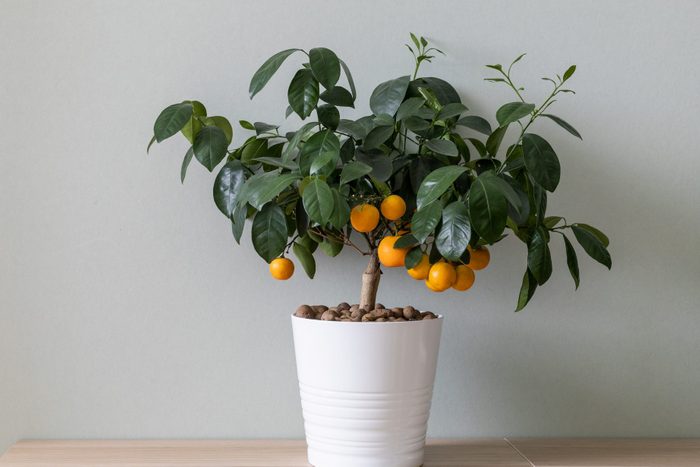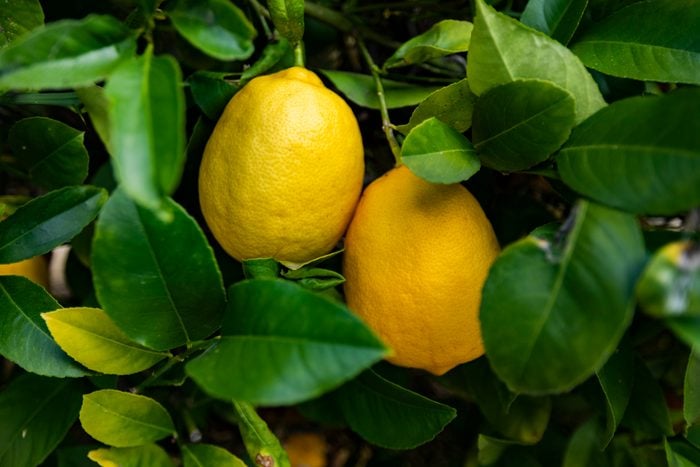 Tetra Images/Getty Images
Tetra Images/Getty Images
Dwarf Meyer lemon tree
Citrus limon x ‘Meyeri
- Light: Full sun
- Water: Let soil dry out before watering
- Soil: Loamy, slightly acidic soil
- Temperature: 50°F–80°F
Meyer lemons are prized in the kitchen for their perfect balance of tartness and sweetness, and even better, the indoor fruit trees that produce them are easy to grow. “Dwarf Meyer lemon trees are self-pollinating and require relatively little heat for the fruit to ripen,” says Blake Harris, a second-generation horticulturalist. But they need lots of humidity, so spritz yours regularly or put it next to a humidifier.
The soil you choose is also essential for your tree’s health. “For maximum fruit production,” Harris says, “make sure to use a slightly acidic, loam-based soil—a combination of sand, silt and clay—which mirrors the soil composition in the parts of the country where they naturally grow best.” And here’s another bit of info you’ll want when you harvest your haul: how to store lemons the right way.
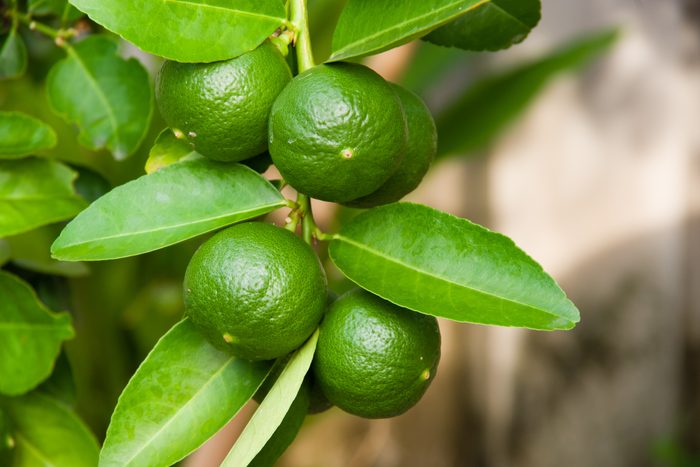 nrngkh chach kan sukh / EyeEm/Getty Images
nrngkh chach kan sukh / EyeEm/Getty Images
Dwarf Key lime tree
Citrus aurantiifolia
- Light: Full sun
- Water: Keep soil moist but never soggy
- Soil: Well-draining potting soil
- Temperature: 65°F–75°F
Is there anything more summery than a Key lime pie? Make your own at home—after growing the fruit you need for it at home too! The key here is making sure your Dwarf Key lime tree receives sufficient sunlight every day. Also, don’t overwater it, because these trees are prone to root rot. Experts recommend using a well-draining potting soil, as well as letting the soil dry out between each watering. Because Key limes are not self-pollinating, you’ll need to place this tree outside in the summer months so bees can pollinate it to produce fruit.
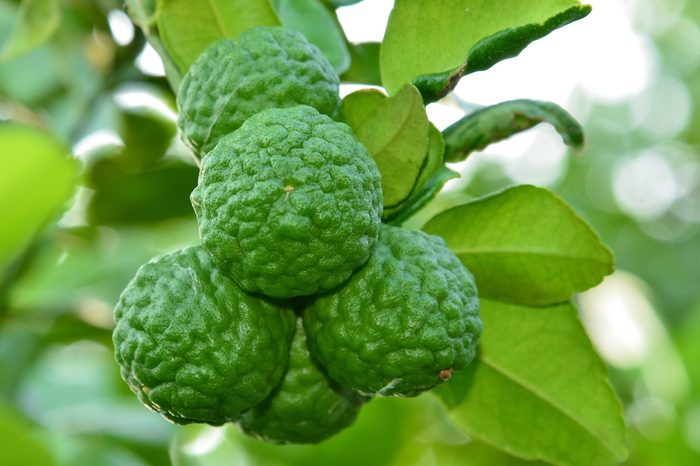 Suntorn Niamwhan/Getty Images
Suntorn Niamwhan/Getty Images
Kaffir lime tree
Citrus hystrix
- Light: Full sun
- Water: Keep soil moist but never soggy
- Soil: Well-draining potting soil
- Temperature: 65°F–75°F
Kaffir limes, also known as Makrut limes, are great for cooking and easy to grow indoors. The bonus of growing this indoor fruit tree is that you get double the rewards: You can also cook with the leaves, adding them to curries or sauces while you wait for the fruits. Like Key limes, kaffir limes shouldn’t be overwatered and do best when the soil dries out a little before the next watering.
The amount of sunlight and warmth is also important. The plant experts at Bloomscape recommend giving a kaffir lime tree six to eight hours of direct sunlight and turning it every week to ensure all sides get equal sunlight for proper growth. Here are more indoor lighting tips to make sure your indoor fruit trees and other houseplants thrive.
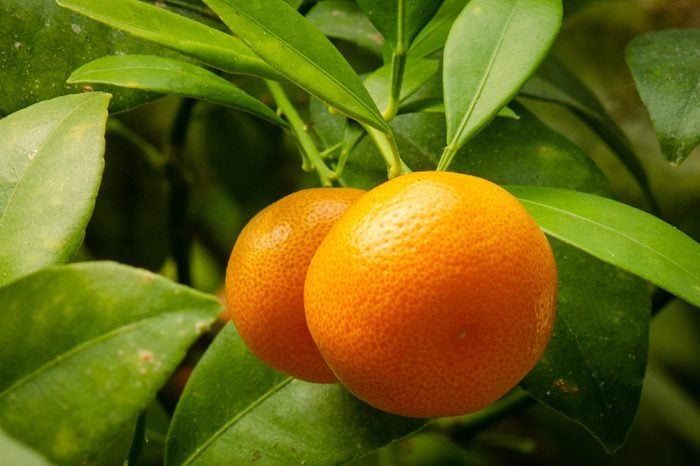 Nancybelle Gonzaga Villarroya/Getty Images
Nancybelle Gonzaga Villarroya/Getty Images
Calamondin dwarf orange tree
Citrus x citrofortunella mitis
- Light: Full sun
- Water: Keep soil moist
- Soil: Loamy soil
- Temperature: 55°F–75°F
Not familiar with calamondins? They’re a variety of small oranges that are known for being juicy and tart—and they’re great for indoor growing conditions, say horticulturalists. Calamondin dwarf trees typically range in height from 4 to 6 feet tall. For the best results, use a loamy soil mix of clay and sand, and make sure to keep it moist. For a calamondin to live a long, happy life, don’t let the soil dry out completely. Translation: You need to be an attentive plant parent, unlike with these low-maintenance plants that are a lot harder to kill.
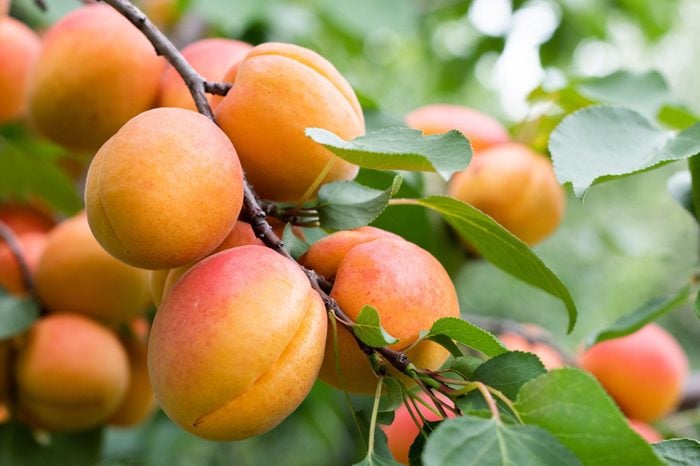 fotokostic/Getty Images
fotokostic/Getty Images
Dwarf Moorpark apricot tree
Prunus armeniaca
- Light: Full sun
- Water: Let soil dry out before watering
- Soil: Loamy soil
- Temperature: 65°F–85°F
It can be a fun experiment to grow this stone-fruit tree from a pit, but don’t expect any actual apricots for two to five years, says Harris. Instead, he suggests opting for a young tree: “If you [do that], you could be enjoying apricots in the first year.” For optimal growing conditions, he advises using a rich, loamy soil and keeping your dwarf Moorpark apricot tree extra happy by mixing in some nutrient-rich compost. Need a reason to buy an apricot tree (aside from the fact that apricots are delicious)? They are one of the foods that are naturally high in digestive enzymes.
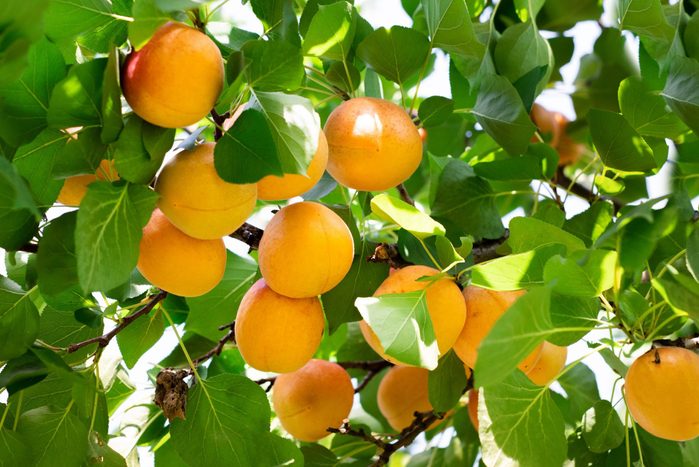 fotokostic/Getty Images
fotokostic/Getty Images
Goldcot apricot tree
Prunus armeniaca ‘Goldcot’
- Light: Full sun
- Water: Keep soil moist but never soggy
- Soil: Loamy soil
- Temperature: 65°F–85°F
Another fantastic choice if you’re dreaming of picking apricots first thing in the morning while still in your pajamas? Try the dwarf variety of the Goldcot apricot tree. Goldcots are delicious to eat fresh from the tree, and if you end up with an abundance, you can always can them.
These indoor fruit trees prefer moist but not soggy soil, and you’ll need to water them regularly to make sure the soil doesn’t dry out. They also need lots of sun, so place your tree by a south-facing window to ensure sufficient light and heat. Just like the Moorpark variety, Goldcots do best with a loamy soil mix of clay and sand, according an expert at Bloomscape. If you don’t have a lot of sunlight in your space, you might be better off with these low-light houseplants that thrive in near darkness.
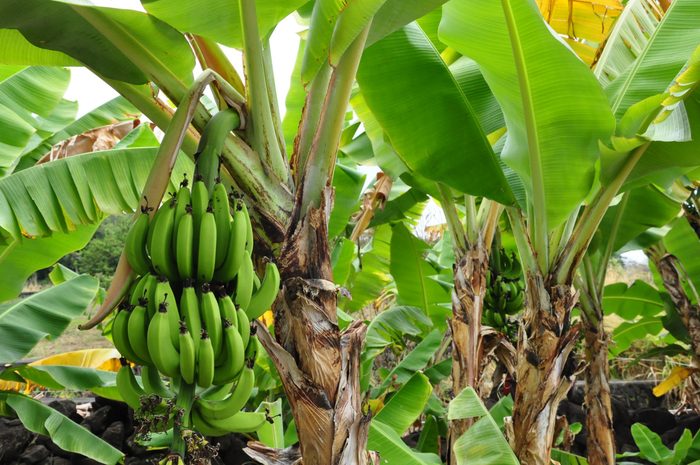 BobWC/Getty Images
BobWC/Getty Images
Musa dwarf Cavendish banana tree
Musa acuminata
- Light: Full sun
- Water: Water every 2–3 days and keep soil moist
- Soil: Well-draining soil
- Temperature: 67°F–80°F
Banana trees are low-maintenance plants that are relatively easy to take care of, as long as they receive ample sunlight and the proper temperature is maintained. Experts say indoor banana trees do best when placed near a south-facing window for sufficient sunlight and in temperatures around 80°F during the day and about 67°F at night. Bananas are tropical plants that also need a lot of humidity, so give them regular mistings to keep them happy and thriving. Looking for other humidity-loving plants? Consider these bathroom plants.
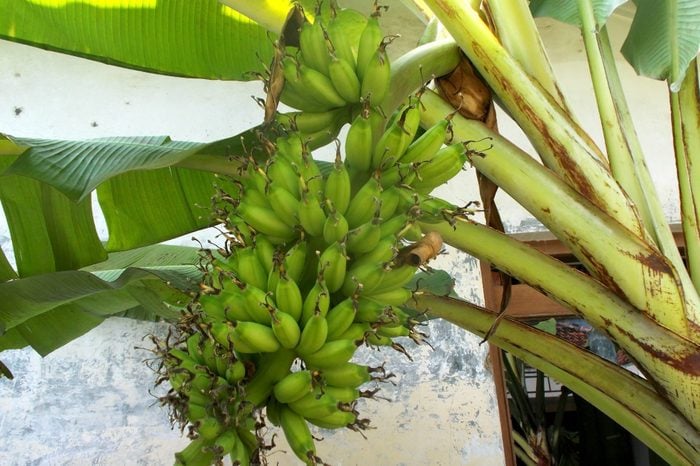 rue015/Getty Images
rue015/Getty Images
Dwarf lady finger banana tree
Musa acuminata
- Light: Full sun
- Water: Keep soil moist
- Soil: Well-draining potting soil
- Temperature: 65°F–80°F
Another dwarf banana variety is the lady finger, which hails from the South Pacific. Just like the dwarf Cavendish, this variety also needs a lot of heat and sunlight. When it comes to watering, it’s important to water frequently but not oversaturate the soil. Banana trees grown indoors will need more water than those grown outside. However, always make sure the plant is never allowed to sit in water, as this will cause root rot. Allow the plant to dry out just a bit between watering. Consider making your own compost to give a nutrient boost to your indoor fruit trees.
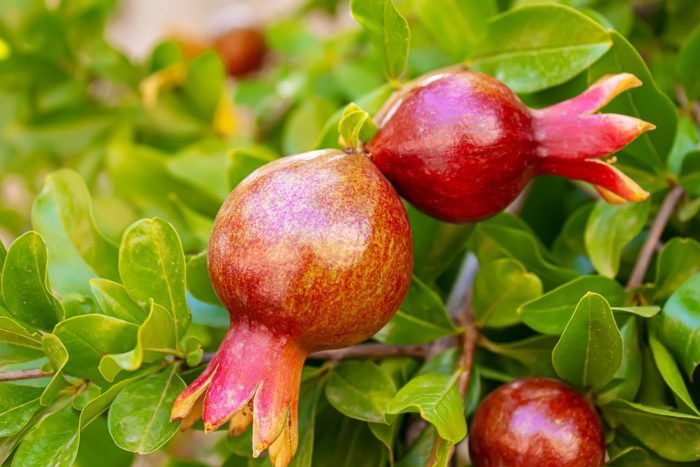 Milena Khosroshvili/Getty Images
Milena Khosroshvili/Getty Images
Dwarf pomegranate tree
Punica granatum
- Light: Full sun
- Water: Keep soil moist
- Soil: Loamy soil
- Temperature: 50°F and higher
Dwarf pomegranate trees are easy to care for, do best in warmer climates and can grow between 2 and 4 feet tall. These trees love plenty of light, so place them in an area of your home that gets sun every day, says Palomares. These trees typically take three years before they begin to produce fruit, and they bloom in late spring or summer. “Be mindful that during its blooming season, if it does not flower, it could mean it is not getting enough light, so the tree can be moved outdoors during the day to help it grow,” Palomares says. “However, it should always be brought back inside at night, as it cannot tolerate temperatures lower than 50°F.” FYI, here’s what it means if your plant has brown tips on its leaves.
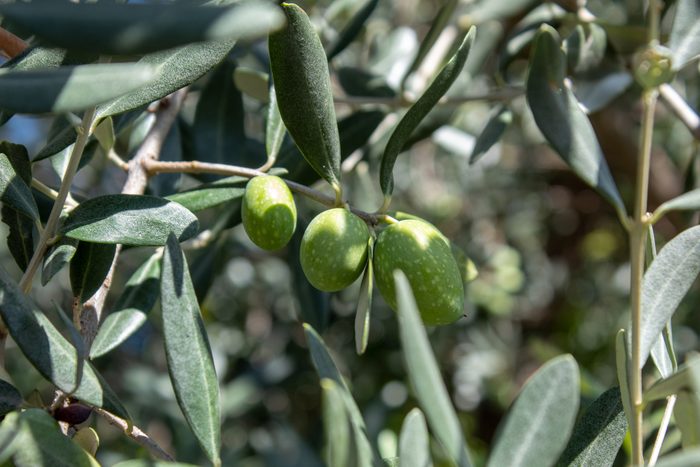 Antonino Petronio/Getty Images
Antonino Petronio/Getty Images
Olive tree
Olea europaea
- Light: Full sun
- Water: Once a week
- Soil: Well-draining potting mix
- Temperature: 65°F–80°F
You may be surprised to learn that you can grow an olive tree inside, but it’s actually one of the fruit trees that do quite well in a home. Native to the Mediterranean, olive trees love the sun. “They do need more light than some other indoor trees, so make sure to place your [olive tree] near a window where it will get at least six to seven hours of sunlight,” says Harris. This is a Spanish variety of olive called Arebequina. Expect to harvest olives within three to five years.
You’ll be happy to know that olive trees are safe for dogs. These poisonous plants for dogs, on the other hand, are not, so avoid them or keep them well out of reach of your fur babies.
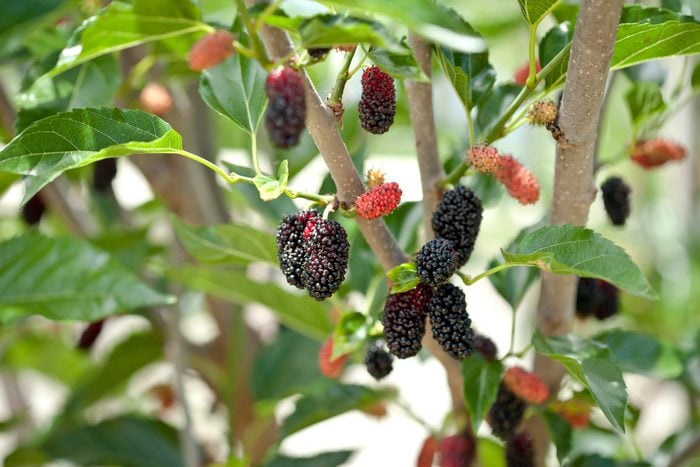 Jenny Dettrick/Getty Images
Jenny Dettrick/Getty Images
Dwarf mulberry tree
Morus nigra
- Light: Full sun
- Water: Keep soil moist
- Soil: Well-draining soil
- Temperature: 65°F–85°F
Mulberry trees produce berries that resemble black berries and come in various hues of purple, red and even black. “The dwarf mulberry tree can thrive very well in a container, growing from 2 to 6 feet high, and requires infrequent drinks of water and full sun,” says Palomares. “While it tolerates a range of different types of soil, plant parents should be mindful that the mulberry tree is susceptible to root rot if its roots are left in wet soil or pooling water.”
And one more word of warning: When these trees produce fruit, they can easily stain the floor or carpet, according to Palomares. Fruit can drop prematurely, so it’s hard to know when you might have a problem. Put a protective covering under the tree, or opt for a fruitless variety that is ornamental.
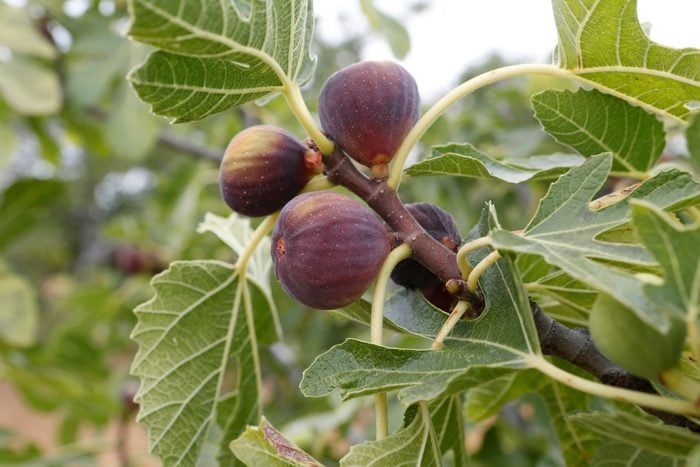 valeniker/Getty Images
valeniker/Getty Images
Brown turkey fig tree
Ficus carica
- Light: Full sun
- Water: About once a week, when soil is dry
- Soil: Loose, well-draining soil
- Temperature: 56°F or higher
If you love snacking on figs when they’re in season, then this is the indoor fruit tree for you. Although there are many varieties, the brown turkey fig tree—with its burgundy to purple skin and bright pink flesh—may be best for your indoor-growing adventures, since it’s easy to care for and adapts well to different conditions. Figs prefer climates with lots of moisture and humidity in the air, so you should mist them regularly but only water them approximately once a week. Go with a loamy soil mix of clay and sand for the best results.
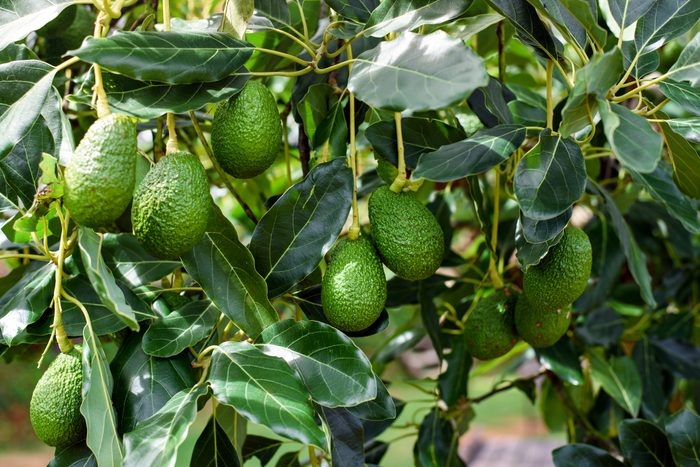 jaboo2foto/Getty Images
jaboo2foto/Getty Images
Avocado tree
Persea americana
- Light: Full sun
- Water: Once a week
- Soil: Well-draining soil
- Temperature: 60°F–85°F
Growing an avocado tree and waiting for it to bear fruit will be a lesson in patience, since many trees can take almost a decade before producing avocados. “Avocado trees grow successfully in warmer seasons, thrive in temperatures of 60 to 85°F and prefer high humidity,” says Palomares. Avocado trees also require at least six hours of direct sunlight, so their home should be near a south- or west-facing window. Grow these indoor fruit trees in well-drained soil, and water them weekly, and eventually, you’ll be making avocado toast and guacamole to your heart’s content. You may just end up thinking that houseplants are better than pets!
Sources:
- Alfred Palomares, vice president of merchandising and resident plant dad at 1-800 Flowers.com
- Bloomscape expert
- Blake Harris, second-generation horticulturalist

